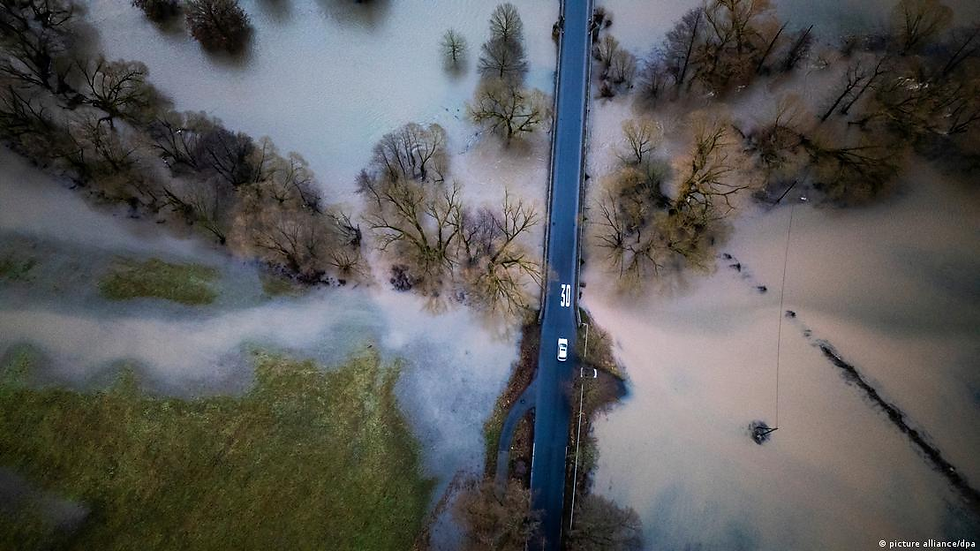Germany: Flooding persists in north and east, Scholz visits
- correspondent005
- Jan 4, 2024
- 3 min read
A colder and drier weather front is bearing down on the flood-hit regions in northern and eastern Germany, leading to less severe rain and flood warnings. German Chancellor Olaf Scholz will don rubber boots again later.
Floodwaters or flood warnings and high rivers continued to plague much of northern, central and eastern Germany on Thursday morning, even as weather forecasters saw some hope of a gradually improving situation in the coming days.
German Chancellor Olaf Scholz was expected later on Thursday in Saxony-Anhalt, a central and eastern state still facing a series of warnings for its rivers. The small village of Bennungen in the south of the Harz mountains, on the bank of the River Helme, was still on the highest possible alert level on Thursday morning.
Scholz's visit comes as members of his center-left Social Democrat Party (SPD), which is the dominant political force in much of the worst-hit areas in northern Germany, call on the federal government to consider declaring a state of emergency that would allow it to borrow extra money to help with the flood relief.
Scholz's federal coalition would be "well advised to address openly the question of whether the exceptional circumstances provision" that allows Berlin to disregard its own rules on a balanced annual budget "is not also suitable for this event, as well as for [Russia's invasion of] Ukraine and for the Ahr Valley catastrophe," senior SPD politician Rolf Mützenich told the Table.Media news outlet, referring to extremely severe flooding in western Germany in 2021.
Saxony-Anhalt, Saxony — Dams holding in southern Harz mountains
Chancellor Scholz, Environment Minister Steffi Lemke and Saxony-Anhalt's state premier, Reiner Haseloff, were to visit the southern Harz mountains on Thursday to get a closer look at the situation. Scholz also visited the neighboring state of Lower Saxony last week.
Forecasters still expect rains on Thursday and Friday in the region, but not to the same extent as in the previous days. By the weekend, a colder and drier front should bring drier weather, freezing temperatures and some snowfall.
"It is getting drier, the heavy rainfalls are stopping," Cathleen Hickmann from the German Weather Service (DWD) told the dpa news agency.
A series of rivers in the state were still subject to level 3 warnings, the second-highest available on the German scale, on Thursday, but only one rural measuring point remained at the highest available alert level.
Further east, in Saxony, water levels were also much higher than usual in major population centers, for instance where the River Elbe flows through central Dresden.
Lower Saxony — First signs of situation easing, extra help in from France
To the west of Saxony-Anhalt in the northern and central state of Lower Saxony, which suffered the worst of the flooding over New Year's in particular, the situation remained critical in several towns and villages.
A spokesman for the state's Interior Ministry told dpa on Thursday that areas including Celle, Oldenburg, Emsland, Osterholz, Verden and Heidekreis were still on high alert.
Around 100,000 people (from emergency services right through to volunteers) had mobilized just in Lower Saxony to help as of Wednesday; French emergency crews were also on hand to assist with flood relief efforts in the state.
The Lilienthal area, not far north of Bremen, was probably the worst-affected area in the state near a major city. Around 20,000 people live there in total, some of whom have had to leave their homes and stay away for several days because of the flood risks. The municipality said on Thursday that some had been able to return home in recent days but dozens of houses and apartments remained empty. Water levels were starting to recede in the area.
Hesse, northern Bavaria — Less critical but still unresolved situation
Parts of Hesse, home to the financial capital Frankfurt, also remained on high alert on Thursday.
The towns of Fulda, on the banks of the river of the same name, and Lahn, with a tributary of the Rhine river named after it, were among the worst affected.
Not far south, near the state boundary to northern Bavaria, towns and villages in Lower Franconia also remained waterlogged.
Source: Dw



















Comments